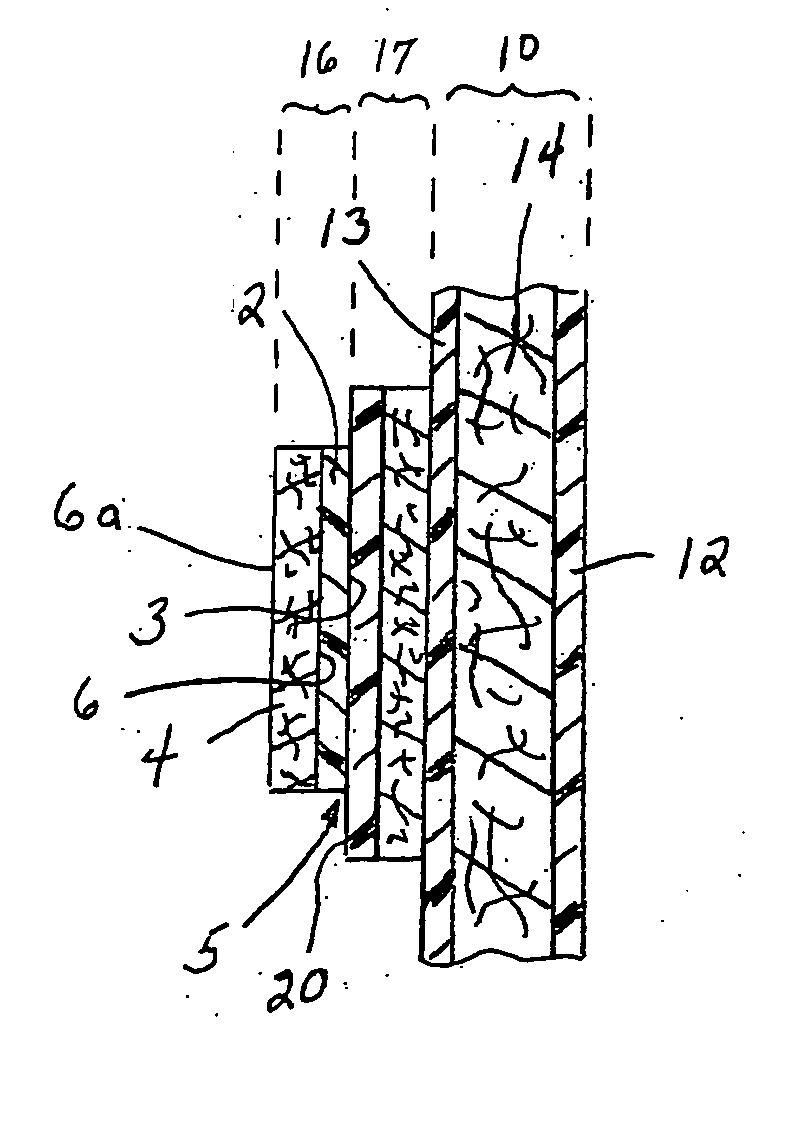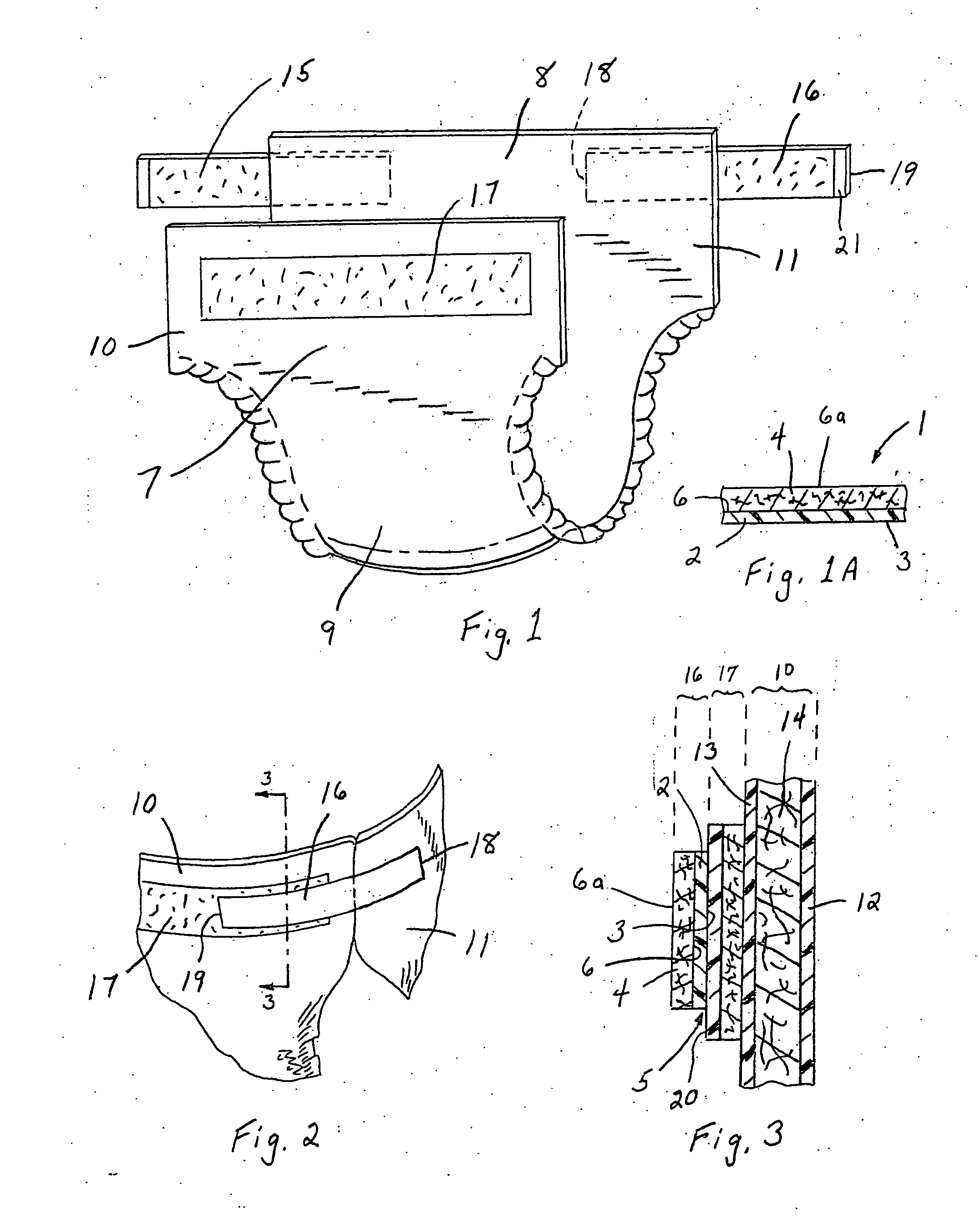Cling film fastening system for disposable soft goods
a technology of cling film and soft goods, which is applied in the direction of packaging goods, labelling articles, paper/cardboard containers, etc., can solve the problems of reducing the ability of the autoadhesive surface of the cling film to adhere, reducing the ability of the autoadhesive surface to adhere, and preventing stretching or deformation of the cling film. , to achieve the effect of reducing the ability of the autoadhesive surface,
- Summary
- Abstract
- Description
- Claims
- Application Information
AI Technical Summary
Benefits of technology
Problems solved by technology
Method used
Image
Examples
example 1
[0059] The improved peel and shear properties of laminates made in accordance with the present invention are illustrated by the data reported in Table 1 below. For each laminate tested the peel strength was 50 g or less and shear strength was acceptable (all samples held for at least 8 hours), not only at room temperature but also after aging at elevated temperatures.
TABLE 1Stored 24 HoursStored 24 hoursInitial Testat 120° F.at 100° F.RoomRoomRoomTemp.Temp.Temp.PeelPeelPeelStrength100° F.Strength100° F.Strength100° F.Chemistry ofCling FilmNW(gm)Shear(gm)Shear(gm)ShearCling SurfacePactiv APM3-2015Avgol50pass58pass34passPoly(Ethylene-alkyl acrylate)Presto CNC 101515Avgol30pass22pass18passPolyethylenePresto CNC 10152Avgol13pass20pass19passPolyethyleneParagon V1 09015AAvgol32pass19pass14passPolyethyleneParagon T1 28370 GlobalAvgol17pass24pass22passPolyethyleneParagon T8 17125Avgol16pass16pass15passPolyethylene
[0060] Method for Preparing the Cling Laminates:
[0061] The cling films were...
example 2
[0070] This example was performed to determine the effect of aging on the peel strength of cling laminates constructed in accordance with the present invention, and to compare the data obtained with that of prior art laminates disclosed in U.S. Pat. No. 5,085,655. Accordingly, the peel test method described in Example 1 was once again performed on two inch wide samples of laminate except using a crosshead speed of 10 inches / minute. The average peel strength in grams is reported in Table 2A initially, after one hour, after one day and after 13 days for laminates made in accordance with the present invention. All samples were stored at room temperature (RT) for the designated time period. These data are then compared to the results reported in Mann et al U.S. Pat. No. 5,085,655 which describes a prior art laminate using a styrene-ethylene-butylene-styrene (SEBS) block copolymer or an ethylene-propylene rubber (EPR) as an autoadhesive layer. The Mann et al data is reported in Table 2B....
example 3
[0073] As a further comparison, the peel and shear properties of several currently available commercial diaper fastening systems were obtained and tested in the same manner as for Example 1. The data is illustrated in Table 3 below. It is to be noted that the peel strength for the tape fastening systems tested are significantly higher than the laminates of the present invention and increase substantially during aging for 8 hours at 100° F.
[0074] Peel Values for Various Commercial Fastening Systems:
[0075] Several samples of commercially sold diapers were obtained for testing. Two of them used a conventional pressure sensitive tape tab and two used a mechanical fastener system. The same basic peel test that was described previously was used with the following modifications.
[0076] The landing zone for each diaper was cut out of the diaper. In the case of the pressure sensitive tape tab, the landing zone consisted of a piece of polypropylene film bonded to the backsheet with a releas...
PUM
| Property | Measurement | Unit |
|---|---|---|
| storage temperature | aaaaa | aaaaa |
| storage temperature | aaaaa | aaaaa |
| thickness | aaaaa | aaaaa |
Abstract
Description
Claims
Application Information
 Login to View More
Login to View More - R&D
- Intellectual Property
- Life Sciences
- Materials
- Tech Scout
- Unparalleled Data Quality
- Higher Quality Content
- 60% Fewer Hallucinations
Browse by: Latest US Patents, China's latest patents, Technical Efficacy Thesaurus, Application Domain, Technology Topic, Popular Technical Reports.
© 2025 PatSnap. All rights reserved.Legal|Privacy policy|Modern Slavery Act Transparency Statement|Sitemap|About US| Contact US: help@patsnap.com



